Kontaktinformation
Institutionen för anatomi, fysiologi och biokemi (AFB)

Although horses have evolved as grass eaters, performance horses are commonly fed diets including large amounts of starch-rich concentrates. There is little scientific evidence that such diets promote performance. In fact, it is well known that high concentrate diets are associated with gastrointestinal problems, stereotypical behaviour and perhaps also musculoskeletal problems. There is therefore a need for alternative feeding strategies.
Feed utilisation and metabolism in exercising horses
When grass is digested in the gastrointestinal tract of the horse, some glucose (sugar) is absorbed, but production and absorption of fatty acids dominates. These fatty acids are produced during fibre degradation by microorganisms in the digestive tract and are used by the horse as an energy source. When starch-rich concentrates are introduced into the diet, the horse relies more on glucose for its energy metabolism and the availability of fatty acids is reduced. In exercising horses, it has been shown that the energy turnover is more aerobic when horses are adapted to a fat-rich or fibre-rich diet (oil or fibre added instead of some of the starch-rich concentrates), and that more fatty acids and less glucose are used. This could promote performance, since similar adaptations are observed after training. However, digestion of forage is the most natural way for a horse to be adapted to fat and fibre utilisation and eating forage also prolongs the eating time.
Aims of our research
Based on current knowledge, we have therefore conducted a series of studies with the aim of assessing possible benefits and limitations of feeding high energy, grass forage-only diets to athletic horses. Standardbred horses in race training have mainly been used for the studies. These horses are known to have very high energy requirements, comparable to those of, for example, thoroughbred race horses. We have complemented these studies with observations in the field of horses fed forage-only diets, including Standardbred horses and horses used in other sports.
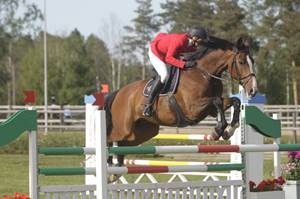
A 13 year old show jumper gelding on a forage-only diet (also a winner but not at this particular photo), photo: Roland Thunholm.
Diets studied
The horses included in our studies were fed grass forages consisting mainly of timothy and meadow fescue. The energy content of the forages was always analysed prior to feeding and was found to be >10 MJ metabolisable energy (corresponding to >11.5 MJ digestible energy) per kg dry matter. To achieve these high energy contents, the forage had to be cut in an early botanical state. The forages were also analysed for crude protein, calcium (Ca), phosphorus (P) and magnesium (Mg) content. In a few cases, the diet had to be supplemented with lucerne/alfalfa to meet the crude protein requirements (according to NRC 2007). In almost all cases, supplementation with Ca and P was needed and vitamins and trace minerals were added to ensure that deficiencies did not occur. The dry matter (DM) content of the forages varied between 45 and 85 % and all batches were preserved in big bales wrapped in plastic.
Results and experiences in brief
The following observations were made:
It is possible for horses to compete and win races on a forage-only diet.The energy content of the forage has to be around 11 MJ metabolisable energy (corresponding to approximately 12-13 MJ digestible energy) per kg dry matter to maintain body condition.Because of the very high digestibility (high energy content) of the forages used, horses will not become "bulky" (see pictures). The lactate threshold (speed at which lactate accumulation occurs) with a forage-only diet may be higher than with a high concentrate diet, indicating improved performance.The plasma glucose concentration following exercise may be higher than with a high concentrate diet, which may improve performance.The venous pH during exercise may be higher than with a high concentrate diet, which could partly counteract the acidosis induced by high intensity exercise and improve performance.The muscle glycogen content at rest may be slightly reduced (-10%) compared with a high concentrate diet. Marked muscle glycogen depletion is known to reduce performance, but the effect of small reductions on high intensity exercise remains to be determined.Muscle glycogen content can be increased to very high levels with high crude protein forage (providing >150% of requirements) and this type of forage could therefore be used during the recovery period. The increase could be due to increased leucine intake and insulin response. High crude protein intake can exacerbate exercise-induced acidosis and is perhaps not recommended prior to competition.
10. Heat production and evaporative losses may increase with high crude protein intake, which should be considered in horses subjected to high sweat losses (for example endurance horses, hot and humid conditions).
11. Evaporative losses may be higher with silage (DM <50%) than with hay, which should be considered in horses subjected to high sweat losses (for example endurance exercise, hot and humid conditions).
12. Growth response may be similar or better in young horses with free access to high energy forage than previously reported in young horses of light breeds.
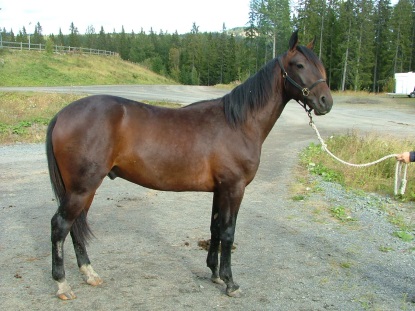
Standardbred yearling in training on a forage-only diet (photo: SLU).
13. Training response may be similar in young horses with free access to high energy forage as in horses in conventional training.
14. In general, temperament during exercise appears not to be affected by crude protein intake or high concentrate or forage-only diets, but variations in individual responses cannot be excluded.
15. Less aggression during waiting for entry to the stable from the paddock was observed in a group of horses fed a forage-only than in the same horses fed a high concentrate diet.
16. We did not observe any health problems that could be related to the grass forages used during the studies.
17. Maximal voluntary feed intake appears to be 2-2.5% of BW.
18. Three, but not two, feeding stations (big bales) seem to be enough to maintain body condition in 16 free ranged ad libitum fed Standardbred horses in training.
19. Some "hard keepers" that have been fed a high concentrate diet for most of their life may need a very long adaptation period (months) before they can maintain body condition on a forage-only diet, even if the forage has a high energy content.
20. A horse that cannot maintain condition on a high energy forage-only diet could have some health problems (for example pain). A reduction in voluntary time spent on feed intake will have a more rapid and clear effect in forage-fed horses than in concentrate-fed horses because concentrates are consumed more quickly and can be very palatable.
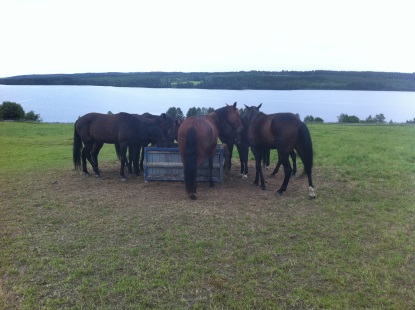
Three, but not two, feeding stations (big bales) seem to be enough to maintain body condition in 16 free ranged ad libitum fed Standardbreds in training on a high energy forage-only diet. (photo: SLU)
21. Digestibility of forages seems not to differ substantially between breeds considered to be normal/hard keepers (Standardbred horses) and easy keepers (Icelandic horses).
22. There may be a small increase in body weight (<1% of body weight) at rest compared with horses on a high concentrate diet, but this difference disappears after transportation (for example to a competition).
23. The faecal microflora in horses was shown to be more stable on a forage-only diet than on a conventional high starch diet. The flora also included fewer lactobacilli, especially Streptococcus bovis/equinus. Lactobacillus ruminis was found in horses on a high concentrate diet, but not in the same horses on a forage-only diet.
24. Rapid feed changes between different forage batches can affect faecal composition (for example pH, water and crude protein content) and microflora. Changes should therefore be made over several days or weeks in order to minimise the risk of gastrointestinal disturbances. This is especially important in horses on high feed intake levels and if crude protein content and conservation method differ.
25. It is possible that minor unwanted growth of microorganisms in forages (not currently considered a hygiene problem) can affect palatability and reduce voluntary forage intake.
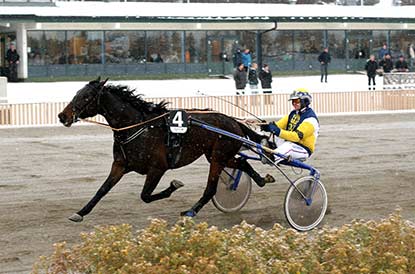
A three year old winning race at local level on a forage-only diet (photo: Tom Jönehag)
Conclusions
The studies and observations we have performed so far indicate that diets based on high energy forage may be an interesting alternative to the conventional high starch diets commonly offered to athletic horses. Forage-based diets could support better health and welfare and may not be a limitation to performance. However, the forages used must be analysed and any lack of nutrients (protein, Ca, P, Mg and trace minerals) supplemented. If body condition cannot be not maintained (<4-6 on the Henneke scale), an energy supplement must be provided. With all forages, there may also be a need for vitamin E supplementation.
Table 1. Guidelines values for the energy and crude protein (CP) content of forages suitable for exercising horses. If these guidelines are applied, the need for supplementation with concentrates will be limited. Observe that the dark and light grey areas show the same information, but use different units
*DE=digestible energy; ME=metabolisable energy. aIf horses are to maintain condition on forage only, >12 MJ DE and >10.5 MJ ME are required. bExcessive (>8 g CP/MJ DE and >7 g digestible CP/MJ ME) crude protein intake prior to exercise may not be optimal for performance, but could be beneficial during recovery.
Studies mainly performed by
Anna Jansson (SLU), Malin Connysson (Swedish National Trotting School, Alsen, Sweden), Sara Muhonen (SLU), Sara Ringmark (SLU), Jan Erik Lindberg (SLU), Birgitta Essén-Gustavsson (SLU).
Peer-reviewed publications
Palmgren Karlsson C, Lindberg J, Jansson A and Essén-Gustavsson B (2002) Effect of molassed sugar beet pulp on nutrient utilisation and metabolic parameters during exercise. Equine Vet. J. Suppl. 34, 44-49.
Connysson M, Muhonen S, Lindberg J E, Essén-Gustavsson B, Nyman G, Nostell K and Jansson A (2006) Effects on exercise response, fluid and acid-base balance of protein intake from forage-only diets in Standardbred horses. Equine vet. J. Suppl. 36, 648-653.
Muhonen S, Connysson M, Lindberg J E, Julliand V, Bertilsson J and Jansson A (2008) Effects of crude protein intake from grass silage-only diets on the equine colon ecosystem after an abrupt feed change. J. Animal Science 86, 3465-3472.
Jansson A and Lindberg J E. (2008) Effects of a forage-only diet on body weight and response to interval training on a track. EAAP Publication no. 125, 4th European Workshop Equine Nutrition, Finland, 345-350.
Muhonen S, Julliand V, Lindberg J E, Bertilsson J and Jansson A (2009) Effects on the equine colon ecosystem of feeding silage or haylage after an abrupt change from hay. J. Animal Science 87 (7), 2291-2298.
Muhonen S, Lindberg J E, Bertilsson J and Jansson A (2009) Effects on fluid balance and exercise response in Standardbred horses feed silage, haylage and hay. Comparative Exercise Physiology 5 (3-4), 133-142.
Willing B, Vörös S, Roos S, Jones A, Jansson A and Lindberg, J E (2009) Changes in faecal bacteria associated with concentrate and forage-only diets fed to horses in training. Equine Vet J. 41 (1), 908-914.
Ragnarsson S and Jansson A (2010) A comparison of grass haylage digestibility and metabolic plasma profile in Icelandic and Standardbred horses. J Anim Physiol Anim Nutr. DOI: 10.1111/j.1439-0396.2010.01049.x
Connysson M, Essén-Gustavsson B, Lindberg J E and Jansson A (2010) Effects of feed deprivation on Standardbred horses in training fed a forage-only diet and a 50:50 forage-oats diet. Equine Vet J. Suppl. 38 (42), 335-340.
Essén-Gustavsson B, Connysson M and Jansson A (2010) Effects of crude protein intake from forage-only diets on muscle amino acids and glycogen levels in horses in training. Equine Vet J. Suppl. 38 (42), 341-346.
Jansson A and Lindberg J E (2012) A forage-only diet alters the metabolic response of horses in training. Animal 6 (12), 1939-1946.
Jansson A, Saastamoinen M and Lindberg J E (2012) Forage feeding systems. 6th European Workshop on Equine Nutrition, Portugal, 2012.
Ringmark S, Roepstorff L, Essén-Gustavsson B, Revold T, Lindholm A, Hedenström U, Rundgren M, Ögren G and Jansson A (2013) Growth, training response and health in Standardbred yearlings fed a forage-only diet. Animal 7 (5), 746-753.
Jansson A and Harris P (2013) A bibliometric review on nutrition of the exercising horse from 1970 to 2010. Comparative Exercise Physiology. Accepted, soon published Open Access.
Ringmark S and Jansson A (2013) Comparative Exercise Physiology. Accepted, soon published Open Access.
Jansson A (2013) Forage-only diets to horses in training. German Warmblood Breeders Conference, Göttingen, Germany, March 13.
More information:
contact Anna Jansson, anna.jansson@slu.se
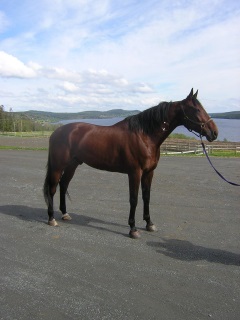
Adult Standardbred in training on a forage only diet (photo: SLU)
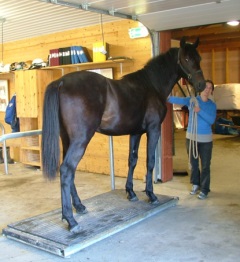
Standardbred yearling in training on a forage-only diet (photo: SLU)
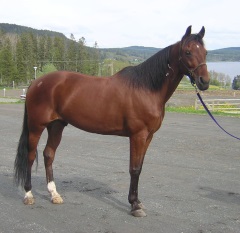
Adult Standardbred in training on a forage only diet (photo: SLU)